
Portraiture of Elizabeth I of England
Encyclopedia
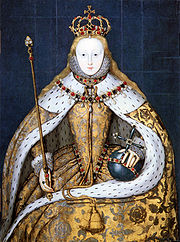
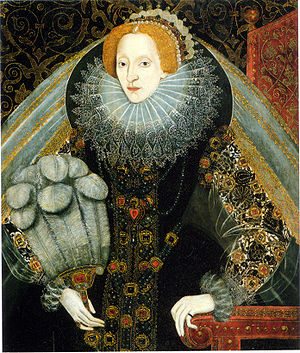
Portrait
thumb|250px|right|Portrait of [[Thomas Jefferson]] by [[Rembrandt Peale]], 1805. [[New-York Historical Society]].A portrait is a painting, photograph, sculpture, or other artistic representation of a person, in which the face and its expression is predominant. The intent is to display the likeness,...
s in the Early Modern period
Early modern period
In history, the early modern period of modern history follows the late Middle Ages. Although the chronological limits of the period are open to debate, the timeframe spans the period after the late portion of the Middle Ages through the beginning of the Age of Revolutions...
from the representations of simple likenesses to the later complex imagery used to convey the power and aspirations of the state, as well as of the monarch at its head.
Even the earliest portraits of Elizabeth I of England
Elizabeth I of England
Elizabeth I was queen regnant of England and Ireland from 17 November 1558 until her death. Sometimes called The Virgin Queen, Gloriana, or Good Queen Bess, Elizabeth was the fifth and last monarch of the Tudor dynasty...
(1533–1603) contain symbol
Symbol
A symbol is something which represents an idea, a physical entity or a process but is distinct from it. The purpose of a symbol is to communicate meaning. For example, a red octagon may be a symbol for "STOP". On a map, a picture of a tent might represent a campsite. Numerals are symbols for...
ic objects such as rose
Rose
A rose is a woody perennial of the genus Rosa, within the family Rosaceae. There are over 100 species. They form a group of erect shrubs, and climbing or trailing plants, with stems that are often armed with sharp prickles. Flowers are large and showy, in colours ranging from white through yellows...
s and prayer books that would have carried meaning to viewers of her day. Later portraits of Elizabeth layer the iconography
Iconography
Iconography is the branch of art history which studies the identification, description, and the interpretation of the content of images. The word iconography literally means "image writing", and comes from the Greek "image" and "to write". A secondary meaning is the painting of icons in the...
of empire
Empire
The term empire derives from the Latin imperium . Politically, an empire is a geographically extensive group of states and peoples united and ruled either by a monarch or an oligarchy....
—globe
Globe
A globe is a three-dimensional scale model of Earth or other spheroid celestial body such as a planet, star, or moon...
s, crowns
Crown (headgear)
A crown is the traditional symbolic form of headgear worn by a monarch or by a deity, for whom the crown traditionally represents power, legitimacy, immortality, righteousness, victory, triumph, resurrection, honour and glory of life after death. In art, the crown may be shown being offered to...
, sword
Sword
A sword is a bladed weapon used primarily for cutting or thrusting. The precise definition of the term varies with the historical epoch or the geographical region under consideration...
s and column
Column
A column or pillar in architecture and structural engineering is a vertical structural element that transmits, through compression, the weight of the structure above to other structural elements below. For the purpose of wind or earthquake engineering, columns may be designed to resist lateral forces...
s—and representations of virginity
Virginity
Virginity refers to the state of a person who has never engaged in sexual intercourse. There are cultural and religious traditions which place special value and significance on this state, especially in the case of unmarried females, associated with notions of personal purity, honor and worth...
and purity—such as moon
Moon
The Moon is Earth's only known natural satellite,There are a number of near-Earth asteroids including 3753 Cruithne that are co-orbital with Earth: their orbits bring them close to Earth for periods of time but then alter in the long term . These are quasi-satellites and not true moons. For more...
s and pearl
Pearl
A pearl is a hard object produced within the soft tissue of a living shelled mollusk. Just like the shell of a mollusk, a pearl is made up of calcium carbonate in minute crystalline form, which has been deposited in concentric layers. The ideal pearl is perfectly round and smooth, but many other...
s—with classical
Classical antiquity
Classical antiquity is a broad term for a long period of cultural history centered on the Mediterranean Sea, comprising the interlocking civilizations of ancient Greece and ancient Rome, collectively known as the Greco-Roman world...
allusions to present a complex "story" that conveyed to Elizabethan era
Elizabethan era
The Elizabethan era was the epoch in English history of Queen Elizabeth I's reign . Historians often depict it as the golden age in English history...
viewers the majesty and significance of their Virgin Queen.
Portraiture in Tudor England
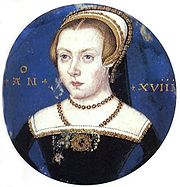
Henry VIII of England
Henry VIII was King of England from 21 April 1509 until his death. He was Lord, and later King, of Ireland, as well as continuing the nominal claim by the English monarchs to the Kingdom of France...
. The portrait miniature
Portrait miniature
A portrait miniature is a miniature portrait painting, usually executed in gouache, watercolour, or enamel.Portrait miniatures began to flourish in 16th century Europe and the art was practiced during the 17th century and 18th century...
developed from the illuminated manuscript
Illuminated manuscript
An illuminated manuscript is a manuscript in which the text is supplemented by the addition of decoration, such as decorated initials, borders and miniature illustrations...
tradition. These small personal images were almost invariably painted from life over the space of a few days in watercolours on vellum
Vellum
Vellum is mammal skin prepared for writing or printing on, to produce single pages, scrolls, codices or books. It is generally smooth and durable, although there are great variations depending on preparation, the quality of the skin and the type of animal used...
stiffened by being glued to a playing card
Playing card
A playing card is a piece of specially prepared heavy paper, thin cardboard, plastic-coated paper, cotton-paper blend, or thin plastic, marked with distinguishing motifs and used as one of a set for playing card games...
. Panel painting
Panel painting
A panel painting is a painting made on a flat panel made of wood, either a single piece, or a number of pieces joined together. Until canvas became the more popular support medium in the 16th century, it was the normal form of support for a painting not on a wall or vellum, which was used for...
s in oils
Oil painting
Oil painting is the process of painting with pigments that are bound with a medium of drying oil—especially in early modern Europe, linseed oil. Often an oil such as linseed was boiled with a resin such as pine resin or even frankincense; these were called 'varnishes' and were prized for their body...
on prepared wood surfaces were based on preparatory drawings and were usually executed at life size, as were oil paintings on canvas.
Unlike her contemporaries in France, Elizabeth never granted rights to produce her portrait to a single artist, although Nicholas Hilliard
Nicholas Hilliard
Nicholas Hilliard was an English goldsmith and limner best known for his portrait miniatures of members of the courts of Elizabeth I and James I of England. He mostly painted small oval miniatures, but also some larger cabinet miniatures, up to about ten inches tall, and at least two famous...
was appointed her official limner or miniaturist and goldsmith. George Gower
George Gower
George Gower was an English portrait painter who became Serjeant Painter to Queen Elizabeth I in 1581.-Life:Little is known about his early life except that he was a grandson of Sir John Gower of Stettenham, Yorkshire....
, a fashionable court portraitist created Serjeant Painter
Serjeant Painter
The Serjeant Painter was an honorable and lucrative position with the British monarchy. It carried with it the prerogative of painting and gilding all of the King's residences, coaches, banners, etc. and it grossed over £ 1,000 in a good year by the 18th century...
in 1581, was responsible for approving all portraits of the queen created by other artists from that date until his death in 1596. Elizabeth sat to a number of artists over the years, including Hilliard, Cornelis Ketel
Cornelis Ketel
Cornelis or Cornelius Ketel was a Dutch Mannerist painter, active in Elizabethan London from 1573 to 1581, and in Amsterdam from 1581 to the early 17th century, now known essentially as a portrait-painter, though he was also a poet and orator, and from 1595 began to sculpt as well.According to...
, Federico Zuccaro or Zuccari
Federico Zuccari
Federico Zuccari, also known as Federigo Zuccaro , was an Italian Mannerist painter and architect, active both in Italy and abroad.-Biography:Zuccari was born at Sant'Angelo in Vado, near Urbino ....
, Isaac Oliver
Isaac Oliver
Isaac Oliver was a French-born English portrait miniature painter.-Life and work:Born in Rouen, he moved to London in 1568 with his Huguenot parents Peter and Epiphany Oliver to escape the Wars of Religion in France...
, and most likely to Gower and Marcus Gheeraerts the Younger
Marcus Gheeraerts the Younger
Marcus Gheeraerts was an artist of the Tudor court, described as "the most important artist of quality to work in England in large-scale between Eworth and Van Dyck" He was brought to England as a child by his father Marcus Gheeraerts the Elder, also a painter...
.
Portraits were commissioned by the government as gifts to foreign monarchs and to show to prospective suitors. Courtiers commissioned heavily symbolic paintings to demonstrate their devotion to the queen. The fashionable long galleries
Long gallery
Long gallery is an architectural term given to a long, narrow room, often with a high ceiling. In British architecture, long galleries were popular in Elizabethan and Jacobean houses. They were often located on the upper floor of the great houses of the time, and stretched across the entire...
of later Elizabethan country houses were filled with sets of portraits. The studios of Tudor artists produced images of Elizabeth working from approved "face patterns" or drawings of the queen to meet this growing demand for her image, an important symbol of loyalty and reverence for the crown in times of turbulence.

European context
By far the most impressive models available to English portraitists were the many portraits by Hans Holbein the YoungerHans Holbein the Younger
Hans Holbein the Younger was a German artist and printmaker who worked in a Northern Renaissance style. He is best known as one of the greatest portraitists of the 16th century. He also produced religious art, satire and Reformation propaganda, and made a significant contribution to the history...
, the outstanding Northern portraitist of the first half of the century, who had made two lengthy visits to England and been Henry VIII's court artist. Holbein had accustomed the English court to the full-length life-size portrait, although none of his originals now survive. His great dynastic mural at Whitehall Palace, destroyed in 1698, and perhaps other original large portraits, would have been familiar to Elizabethan artists.
Both Holbein and his great Italian contemporary Titian
Titian
Tiziano Vecelli or Tiziano Vecellio Tiziano Vecelli or Tiziano Vecellio Tiziano Vecelli or Tiziano Vecellio (c. 1488/1490 – 27 August 1576 better known as Titian was an Italian painter, the most important member of the 16th-century Venetian school. He was born in Pieve di Cadore, near...
had combined great psychological penetration with a sufficiently majestic impression to satisfy their royal patrons. By his second visit Holbein was already moving away from a strictly realist depiction; in his Jane Seymour
Jane Seymour
Jane Seymour was Queen of England as the third wife of King Henry VIII. She succeeded Anne Boleyn as queen consort following the latter's execution for trumped up charges of high treason, incest and adultery in May 1536. She died of postnatal complications less than two weeks after the birth of...
(left) "the figure is no longer seen as displacing with its bulk a recognizable section of space: it approaches rather to a flat pattern, made alive by a bounding and vital outline". This tendency was to be taken much further by the later portraits of Elizabeth, where "Likeness of feature and an interest in form and volume have gradually been abandoned in favour of an effect of splendid majesty obtained by decorative pattern, and the forms have been flattened accordingly".

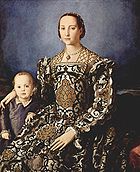
Philip II of Spain
Philip II was King of Spain, Portugal, Naples, Sicily, and, while married to Mary I, King of England and Ireland. He was lord of the Seventeen Provinces from 1556 until 1581, holding various titles for the individual territories such as duke or count....
, until the 1570s, but in sharply reduced numbers after about 1555, and he refused to travel from Venice to do them. The full length portrait of Philip (1550–51) now in the Prado was sent to Elizabeth's elder sister and predecessor Queen Mary I of England in advance of their marriage.
Towards the mid-century the most influential Continental courts came to prefer less revealing and intimate works, and at the mid-century the two most prominent and influential royal portraitists in paint, other than Titian, were the Netherlandish Anthonis Mor and Agnolo Bronzino in Florence
Florence
Florence is the capital city of the Italian region of Tuscany and of the province of Florence. It is the most populous city in Tuscany, with approximately 370,000 inhabitants, expanding to over 1.5 million in the metropolitan area....
, besides whom the Habsburg court sculptor and medallist Leone Leoni
Leone Leoni
Leone Leoni was an Italian sculptor of international outlook who travelled in Italy, Germany, Austria, France, the Spanish Netherlands and Spain. Leoni is regarded as the finest of the Cinquecento medallists. He made his reputation in commissions he received from the Habsburg monarchs Charles V,...
should also be mentioned. Mor, who had risen rapidly to prominence in 1540s, worked across Europe for the Habsburgs in a tighter and more rigid version of Titian's compositional manner, drawing also on the North Italian style of Moretto. Mor had actually visited London in 1554, and painted three versions of his well-known portrait of Queen Mary; he also painted English courtiers who visited Antwerp.
Mor's Spanish pupil Alonso Sánchez Coello
Alonso Sánchez Coello
Alonso Sánchez Coello was a portrait painter of the Spanish Renaissance and one of the pioneers of the great tradition of Spanish portrait painting.- Life :...
continued in a stiffer version of his master's style, replacing him as Spanish court painter in 1561. Sofonisba Anguissola
Sofonisba Anguissola
Sofonisba Anguissola was an Italian painter of the Renaissance.-The Anguissola family:...
had painted in an intimately informal style, but after her recruitment to the Spanish court as the Queen's painter in 1560 was able to adapt her style to the much more formal demands of state portraiture. Moretto's pupil Giovanni Battista Moroni
Giovanni Battista Moroni
Giovanni Battista Moroni was a North Italian painter of the Late Renaissance period. He is also called Giambattista Moroni...
was Mor's contemporary and formed his mature style in the 1550s, but few of his spirited portraits were of royalty, or yet to be seen outside Italy.
Bronzino developed a style of coldly distant magnificence, based on the Mannerist portraits of Pontormo
Pontormo
Jacopo Carucci , usually known as Jacopo da Pontormo, Jacopo Pontormo or simply Pontormo, was an Italian Mannerist painter and portraitist from the Florentine school. His work represents a profound stylistic shift from the calm perspectival regularity that characterized the art of the Florentine...
, working almost entirely for Cosimo I
Cosimo I de' Medici, Grand Duke of Tuscany
Cosimo I de' Medici was Duke of Florence from 1537 to 1574, reigning as the first Grand Duke of Tuscany from 1569.-Biography:...
, the first Medici Grand-Duke. Bronzino's works, including his striking portraits of Cosimo's Duchess, Eleanor of Toledo were distributed in many versions across Europe, continuing to be made for two decades from the same studio pattern; a new portrait painted in her last years, about 1560, exists in only a few repetitions. At the least many of the foreign painters in London are likely to have seen versions of the earlier type, and there may well have been one in the Royal Collection
Royal Collection
The Royal Collection is the art collection of the British Royal Family. It is property of the monarch as sovereign, but is held in trust for her successors and the nation. It contains over 7,000 paintings, 40,000 watercolours and drawings, and about 150,000 old master prints, as well as historical...
.
French portraiture remained dominated by small but finely drawn bust-length or half-length works, including many drawings, often with colour, by François Clouet
François Clouet
François Clouet , son of Jean Clouet, was a French Renaissance miniaturist and painter, particularly known for his detailed portraits of the French ruling family.-Historical references:Clouet was born in Tours....
following, with a host of imitators, his father Jean
Jean Clouet
Jean Clouet was a miniaturist and painter who worked in France during the Renaissance. He was the father of François Clouet.-Biography:Clouet was allegedly born in Brussels....
, or even smaller oils by the Netherlandish Corneille de Lyon
Corneille de Lyon
Corneille de Lyon was a Dutch painter of portraits who was active from 1533 until his death in Lyon, France...
and his followers, typically no taller than a paperback book. A few full-length portraits of royalty were produced, dependent on German or Italian models.
Creating the royal image

Anne Boleyn
Anne Boleyn ;c.1501/1507 – 19 May 1536) was Queen of England from 1533 to 1536 as the second wife of Henry VIII of England and Marquess of Pembroke in her own right. Henry's marriage to Anne, and her subsequent execution, made her a key figure in the political and religious upheaval that was the...
as quiet and studious-looking, ornament in her attire as secondary to the plainness of line that emphasizes her youth. Great is the contrast with the awesome fantasy of the later portraits: the pallid, mask-like features, the extravagance of headdress and ruff, the padded ornateness that seemed to exclude all humanity."
The lack of emphasis given to depicting depth and volume in her later portraits may have been influenced by the Queen's own views. In the Art of Limming Hilliard cautioned against all but the minimal use of chiaroscuro
Chiaroscuro
Chiaroscuro in art is "an Italian term which literally means 'light-dark'. In paintings the description refers to clear tonal contrasts which are often used to suggest the volume and modelling of the subjects depicted"....
modelling that we see in his works, reflecting the views of his patron: "seeing that best to show oneself needeth no shadow of place but rather the open light...Her Majesty..chose her place to sit for that purpose in the open alley of a goodly garden, where no tree was near, nor any shadow at all..."
From the 1570s, the government sought to manipulate the image of the queen as a object of devotion and veneration. Sir Roy Strong
Roy Strong
Sir Roy Colin Strong FRSL is an English art historian, museum curator, writer, broadcaster and landscape designer. He has been director of both the National Portrait Gallery and the Victoria and Albert Museum in London...
writes: "The cult of Gloriana was skilfully created to buttress public order and, even more, deliberately to replace the pre-Reformation
English Reformation
The English Reformation was the series of events in 16th-century England by which the Church of England broke away from the authority of the Pope and the Roman Catholic Church....
externals of religion, the cult of the Virgin and saint
Saint
A saint is a holy person. In various religions, saints are people who are believed to have exceptional holiness.In Christian usage, "saint" refers to any believer who is "in Christ", and in whom Christ dwells, whether in heaven or in earth...
s with their attendant images, processions, ceremonies and secular rejoicing." The pageantry of the Accession Day tilt
Accession Day tilt
The Accession Day tilts were a series of elaborate festivities held annually at the court of Elizabeth I of England to celebrate her Accession Day, 17 November, also known as Queen's Day...
s, the poetry of the court, and the most iconic of Elizabeth's portraits all reflect this effort. The management of the queen's image reached its heights in the last decade of the reign, when realistic images of the aging queen were replaced with an eternally youthful vision defying the reality of the passage of time.
Early portraits
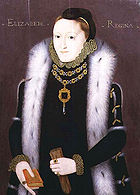
The young queen
Portraits of the young queen, many of them likely painted to be shown to prospective suitors and foreign heads of state, show a naturalness and restraint similar to those in the portrait of Elizabeth as a princess.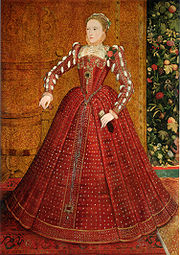
Steven van der Meulen
Steven van der Meulen was a Dutch artist active c. 1543-1564. He gained prominence in England in the first decade of the reign of Elizabeth I as one of many Flemish artists active at the Tudor court...
has been identified by Sir Roy Strong as an important early portrait, "undertaken at a time when her image was being tightly controlled. 'This is a portrait dating from the mid to late 1560s, one of a group produced in response to a crisis over the production of the royal image, one which was reflected in the words of a draft proclamation dated 1563,' he said." The draft proclamation (never published) was a response to the circulation of poorly-made portraits in which Elizabeth is shown "in blacke with a hoode and cornet
French hood
A French hood is a type of woman's headgear popular in Western Europe in the sixteenth century.The French hood is characterized by a rounded shape, contrasted with the angular "English" or gable hood. It is worn over a coif, and has a black veil attached to the back. It was introduced to England...
", a style she no longer wore. Symbolism in these pictures is in keeping with earlier Tudor portraiture; in some Elizabeth holds a book (possibly a prayer book) suggesting studiousness or piety. In other paintings she holds or wears a red rose, symbol of the Tudor Dynasty
Tudor dynasty
The Tudor dynasty or House of Tudor was a European royal house of Welsh origin that ruled the Kingdom of England and its realms, including the Lordship of Ireland, later the Kingdom of Ireland, from 1485 until 1603. Its first monarch was Henry Tudor, a descendant through his mother of a legitimised...
's descent from the House of Lancaster
House of Lancaster
The House of Lancaster was a branch of the royal House of Plantagenet. It was one of the opposing factions involved in the Wars of the Roses, an intermittent civil war which affected England and Wales during the 15th century...
, or white roses, symbols of the House of York
House of York
The House of York was a branch of the English royal House of Plantagenet, three members of which became English kings in the late 15th century. The House of York was descended in the paternal line from Edmund of Langley, 1st Duke of York, the fourth surviving son of Edward III, but also represented...
and of maidenly chastity. In the Hampden portrait, Elizabeth wears a red rose on her shoulder and holds a gillyflower in her hand. Of this image, Strong says "'Here Elizabeth is caught in that short-lived period before what was a recognisable human became transmuted into a goddess'."
One artist active in Elizabeth's early court was the Flemish
Flanders
Flanders is the community of the Flemings but also one of the institutions in Belgium, and a geographical region located in parts of present-day Belgium, France and the Netherlands. "Flanders" can also refer to the northern part of Belgium that contains Brussels, Bruges, Ghent and Antwerp...
miniaturist Levina Teerlinc
Levina Teerlinc
Levina Teerlinc was a Flemish miniaturist who served as a painter to the English court of Edward VI, Mary I and Elizabeth I....
who had served as a painter and gentlewoman
Gentlewoman
A gentlewoman in the original and strict sense is a woman of good family, analogous to the Latin generosus and generosa...
to Mary I
Mary I of England
Mary I was queen regnant of England and Ireland from July 1553 until her death.She was the only surviving child born of the ill-fated marriage of Henry VIII and his first wife Catherine of Aragon. Her younger half-brother, Edward VI, succeeded Henry in 1547...
and stayed on as a Gentlewoman of the Privy Chamber to Elizabeth. Teerlinc is best known for her pivotal position in the rise of the portrait miniature. There is documentation that she created numerous portraits of Elizabeth I, both individual portraits and portraits of the sovereign with important court figures, but only a few of these have survived and been identified.
Elizabeth and the goddesses

Allegory
Allegory is a demonstrative form of representation explaining meaning other than the words that are spoken. Allegory communicates its message by means of symbolic figures, actions or symbolic representation...
paintings show the early use of classical mythology to illustrate the beauty and sovereignty of the young queen. In Elizabeth I and the Three Goddesses (1569), attributed to Hans Eworth
Hans Eworth
Hans Eworth was a Flemish painter active in England in the mid-16th century. Along with other exiled Flemings, he made a career in Tudor London, painting allegorical images as well as portraits of the gentry and nobility. About 40 paintings are now attributed to Eworth, among them portraits of...
, the story of the Judgement of Paris
Judgement of Paris
thumb |right |460px |[[The Judgment of Paris |The Judgment of Paris]], [[Peter Paul Rubens]], ca 1636...
is turned on its head. Elizabeth, rather than Paris, is now sent to choose among Juno
Juno (mythology)
Juno is an ancient Roman goddess, the protector and special counselor of the state. She is a daughter of Saturn and sister of the chief god Jupiter and the mother of Mars and Vulcan. Juno also looked after the women of Rome. Her Greek equivalent is Hera...
, Venus
Venus (mythology)
Venus is a Roman goddess principally associated with love, beauty, sex,sexual seduction and fertility, who played a key role in many Roman religious festivals and myths...
, and Pallas-Minerva
Athena
In Greek mythology, Athena, Athenê, or Athene , also referred to as Pallas Athena/Athene , is the goddess of wisdom, courage, inspiration, civilization, warfare, strength, strategy, the arts, crafts, justice, and skill. Minerva, Athena's Roman incarnation, embodies similar attributes. Athena is...
, all of whom are outshone by the queen with her crown and royal orb
Globus cruciger
The globus cruciger is an orb topped with a cross , a Christian symbol of authority used throughout the Middle Ages and even today on coins, iconography and royal regalia...
. As Susan Doran writes, "Implicit to the theme of the painting ... is the idea that Elizabeth's retention of royal power benefits her realm. Whereas Paris's judgement in the original myth resulted in the long Trojan War
Trojan War
In Greek mythology, the Trojan War was waged against the city of Troy by the Achaeans after Paris of Troy took Helen from her husband Menelaus, the king of Sparta. The war is among the most important events in Greek mythology and was narrated in many works of Greek literature, including the Iliad...
s 'to the utter ruin of the Trojans', hers will conversely bring peace and order to the state" after the turbulent reign of Elizabeth's sister Mary I
Mary I of England
Mary I was queen regnant of England and Ireland from July 1553 until her death.She was the only surviving child born of the ill-fated marriage of Henry VIII and his first wife Catherine of Aragon. Her younger half-brother, Edward VI, succeeded Henry in 1547...
.
The latter theme lies behind the 1572 The Family of Henry VIII: An Allegory of the Tudor Succession (attributed to Lucas de Heere
Lucas de Heere
Lucas de Heere was a Flemish portrait painter, poet and writer.De Heere was a Protestant and became a refugee from the Dutch Revolt against Philip II of Spain, who tried to suppress Protestantism...
). In this image, Catholic
Roman Catholic Church
The Catholic Church, also known as the Roman Catholic Church, is the world's largest Christian church, with over a billion members. Led by the Pope, it defines its mission as spreading the gospel of Jesus Christ, administering the sacraments and exercising charity...
Mary and her husband Philip II of Spain
Philip II of Spain
Philip II was King of Spain, Portugal, Naples, Sicily, and, while married to Mary I, King of England and Ireland. He was lord of the Seventeen Provinces from 1556 until 1581, holding various titles for the individual territories such as duke or count....
are accompanied by Mars
Mars (mythology)
Mars was the Roman god of war and also an agricultural guardian, a combination characteristic of early Rome. He was second in importance only to Jupiter, and he was the most prominent of the military gods worshipped by the Roman legions...
the god of War on the left, while Protestant Elizabeth on the right ushers in the goddesses Peace and Plenty. An inscription states that this painting was a gift from the queen to Francis Walsingham
Francis Walsingham
Sir Francis Walsingham was Principal Secretary to Elizabeth I of England from 1573 until 1590, and is popularly remembered as her "spymaster". Walsingham is frequently cited as one of the earliest practitioners of modern intelligence methods both for espionage and for domestic security...
as a "Mark of her people's and her own content" and this may indicate that it commemorates the signing of the Treaty of Blois (1572)
Treaty of Blois (1572)
The Treaty of Blois was signed on April 19, 1572 in Blois between Queen Elizabeth of England and Catherine de' Medici of France. Based on the terms of the treaty, France and England relinquished their historic rivalry and established an alliance against Spain...
which established an alliance between England and France against Spanish aggression in the Netherlands during Walsingham's tour of duty as ambassador to the French court. Strong identifies both paintings as celebrations of Elizabeth's just rule by Flemish exiles to whom England was a refuge from the religious persecution of Protestants in the Spanish Netherlands.
Hilliard and the queen

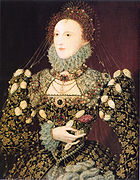

Hilliard's first known miniature of the Queen is dated 1572. It is not known when he was formally appointed limner (miniaturist) and goldsmith to Elizabeth, though he was granted the reversion of a lease by the Queen in 1573 for his "good, true and loyal service." Two panel portraits long attributed to him, the Phoenix and Pelican portraits, are dated c. 1572–76. These paintings are named after the jewels the queen wears, her personal badges of the pelican in her piety and the phoenix
Phoenix (mythology)
The phoenix or phenix is a mythical sacred firebird that can be found in the mythologies of the Arabian, Persians, Greeks, Romans, Egyptians, Chinese, Indian and Phoenicians....
. National Portrait Gallery researchers announced in September 2010 that the two portraits were painted on wood from the same two trees. They also found that a tracing of the Phoenix portrait matches the Pelican portrait in reverse. They therefore deduce that both pictures of Elizabeth in her forties were painted around the same time.
But Hilliard's panel portraits seem to have been found wanting, and in 1576 the recently married Hilliard left for France to improve his skills. Returning to England, he continued to work as a goldsmith, and produced some spectacular "picture boxes" or jewelled lockets for miniatures: the Armada Jewel, given by Elizabeth to Sir Thomas Heneage
Thomas Heneage
Sir Thomas Heneage PC was an English politician and a courtier at the court of Elizabeth I.-Early and personal life:...
and the Drake Pendant given to Sir Francis Drake
Francis Drake
Sir Francis Drake, Vice Admiral was an English sea captain, privateer, navigator, slaver, and politician of the Elizabethan era. Elizabeth I of England awarded Drake a knighthood in 1581. He was second-in-command of the English fleet against the Spanish Armada in 1588. He also carried out the...
are the best known examples. As part of the cult of the Virgin Queen, courtiers were rather expected to wear the Queen's likeness, at least at Court.
His appointment as miniaturist to the Crown included the old sense of a painter of illuminated manuscript
Illuminated manuscript
An illuminated manuscript is a manuscript in which the text is supplemented by the addition of decoration, such as decorated initials, borders and miniature illustrations...
s and he was commissioned to decorate important documents, such as the founding charter
Charter
A charter is the grant of authority or rights, stating that the granter formally recognizes the prerogative of the recipient to exercise the rights specified...
of Emmanuel College, Cambridge
Emmanuel College, Cambridge
Emmanuel College is a constituent college of the University of Cambridge.The college was founded in 1584 by Sir Walter Mildmay on the site of a Dominican friary...
(1584), which has an enthroned Elizabeth under a canopy of estate
Baldachin
A baldachin, or baldaquin , is a canopy of state over an altar or throne. It had its beginnings as a cloth canopy, but in other cases it is a sturdy, permanent architectural feature, particularly over high altars in cathedrals, where such a structure is more correctly called a ciborium when it is...
within an elaborate framework of Flemish-style Renaissance strapwork and grotesque
Grotesque
The word grotesque comes from the same Latin root as "Grotto", meaning a small cave or hollow. The original meaning was restricted to an extravagant style of Ancient Roman decorative art rediscovered and then copied in Rome at the end of the 15th century...
ornament. He also seems to have designed woodcut
Woodcut
Woodcut—occasionally known as xylography—is a relief printing artistic technique in printmaking in which an image is carved into the surface of a block of wood, with the printing parts remaining level with the surface while the non-printing parts are removed, typically with gouges...
title-page frames and borders for books, some of which bear his initials.
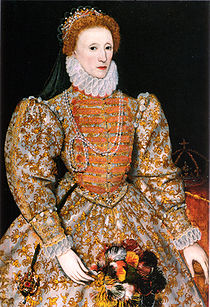
The Darnley Portrait
The problem of an official portrait of Elizabeth was solved with the Darnley Portrait. Likely painted from life around 1575–6, this portrait is the source of a face pattern which would be used and reused for authorized portraits of Elizabeth into the 1590s, preserving the impression of ageless beauty. Sir Roy StrongRoy Strong
Sir Roy Colin Strong FRSL is an English art historian, museum curator, writer, broadcaster and landscape designer. He has been director of both the National Portrait Gallery and the Victoria and Albert Museum in London...
has suggested that the artist is Federico Zuccari
Federico Zuccari
Federico Zuccari, also known as Federigo Zuccaro , was an Italian Mannerist painter and architect, active both in Italy and abroad.-Biography:Zuccari was born at Sant'Angelo in Vado, near Urbino ....
or Zucaro, an "eminent" Italian artist, though not really a specialist portrait-painter, who is known to have visited the court briefly with a letter of introduction to Elizabeth's favourite
Favourite
A favourite , or favorite , was the intimate companion of a ruler or other important person. In medieval and Early Modern Europe, among other times and places, the term is used of individuals delegated significant political power by a ruler...
Robert Dudley, 1st Earl of Leicester
Robert Dudley, 1st Earl of Leicester
Robert Dudley, 1st Earl of Leicester, KG was an English nobleman and the favourite and close friend of Elizabeth I from her first year on the throne until his death...
dated 5 March 1575. Zuccaro's preparatory drawings for full-length portraits of both Leicester and Elizabeth survive, although it is unlikely the full-length of Elizabeth was ever painted.
The Darnley Portrait features a crown and sceptre
Sceptre
A sceptre is a symbolic ornamental rod or wand borne in the hand by a ruling monarch as an item of royal or imperial insignia.-Antiquity:...
on a table beside the queen, and was the first appearance of these symbols of sovereignty separately used as props
Theatrical property
A theatrical property, commonly referred to as a prop, is an object used on stage by actors to further the plot or story line of a theatrical production. Smaller props are referred to as "hand props". Larger props may also be set decoration, such as a chair or table. The difference between a set...
(rather than worn and carried) in Tudor portraiture, a theme that would be expanded in later portraits.
Return of the Golden Age

Excommunication
Excommunication is a religious censure used to deprive, suspend or limit membership in a religious community. The word means putting [someone] out of communion. In some religions, excommunication includes spiritual condemnation of the member or group...
of Elizabeth by Pope Pius V
Pope Pius V
Pope Saint Pius V , born Antonio Ghislieri , was Pope from 1566 to 1572 and is a saint of the Catholic Church. He is chiefly notable for his role in the Council of Trent, the Counter-Reformation, and the standardization of the Roman liturgy within the Latin Church...
in 1570 led to increased tension with Philip II of Spain, who championed the Catholic Mary, Queen of Scots, as the legitimate heir of his late wife Mary I. This tension played out over the next decades in the seas of the New World
New World
The New World is one of the names used for the Western Hemisphere, specifically America and sometimes Oceania . The term originated in the late 15th century, when America had been recently discovered by European explorers, expanding the geographical horizon of the people of the European middle...
as well as in Europe, and culminated in the invasion attempt of the Spanish Armada
Spanish Armada
This article refers to the Battle of Gravelines, for the modern navy of Spain, see Spanish NavyThe Spanish Armada was the Spanish fleet that sailed against England under the command of the Duke of Medina Sidonia in 1588, with the intention of overthrowing Elizabeth I of England to stop English...
.
It is against this backdrop that the first of a long series of portraits appears depicting Elizabeth with heavy symbolic overlays of imperial dominion based on mastery of the seas. Combined with a second layer of symbolism representing Elizabeth as the Virgin Queen, these new paintings signify the manipulation of Elizabeth's image as the destined Protestant protector of her people.
Strong points out that there is no trace of this iconography in portraits of Elizabeth prior to 1579, and identifies its source as the conscious image-making of John Dee
John Dee
John Dee was a Welsh mathematician, astronomer, astrologer, occultist, navigator, imperialist, and consultant to Queen Elizabeth I.John Dee may also refer to:* John Dee , Basketball coach...
, whose 1577 General and Rare Memorials Pertayning to the Perfect Arte of Navigation encouraged the establishment of a British Empire supported by a strong navy, asserting Elizabeth's claims to imperial status via her supposed descent from Brutus of Troy
Brutus of Troy
Brutus or Brute of Troy is a legendary descendant of the Trojan hero Æneas, known in mediæval British legend as the eponymous founder and first king of Britain...
and King Arthur
King Arthur
King Arthur is a legendary British leader of the late 5th and early 6th centuries, who, according to Medieval histories and romances, led the defence of Britain against Saxon invaders in the early 6th century. The details of Arthur's story are mainly composed of folklore and literary invention, and...
.
Dee's inspiration lies in Geoffrey of Monmouth
Geoffrey of Monmouth
Geoffrey of Monmouth was a cleric and one of the major figures in the development of British historiography and the popularity of tales of King Arthur...
's History of the Kings of Britain, which was accepted as true history by Elizabethan poets and formed the basis of the symbolic history of England. In this twelfth century pseudohistory
Pseudohistory
Pseudohistory is a pejorative term applied to a type of historical revisionism, often involving sensational claims whose acceptance would require rewriting a significant amount of commonly accepted history, and based on methods that depart from standard historiographical conventions.Cryptohistory...
, Britain was founded by and named after Brutus, the descendent of Aeneas
Aeneas
Aeneas , in Greco-Roman mythology, was a Trojan hero, the son of the prince Anchises and the goddess Aphrodite. His father was the second cousin of King Priam of Troy, making Aeneas Priam's second cousin, once removed. The journey of Aeneas from Troy , which led to the founding a hamlet south of...
who founded Rome. The Tudors, of Welsh
Wales
Wales is a country that is part of the United Kingdom and the island of Great Britain, bordered by England to its east and the Atlantic Ocean and Irish Sea to its west. It has a population of three million, and a total area of 20,779 km²...
descent, are heirs of the most ancient Britons and thus of Aeneas and Brutus. By uniting the Houses of York and Lancaster following the strife of the Wars of the Roses
Wars of the Roses
The Wars of the Roses were a series of dynastic civil wars for the throne of England fought between supporters of two rival branches of the royal House of Plantagenet: the houses of Lancaster and York...
, the Tudors ushered in a united realm where Pax
Pax (mythology)
In Roman mythology, Pax [paqs] was recognized as a goddess during the rule of Augustus. On the Campus Martius, she had a temple called the Ara Pacis, and another temple on the Forum Pacis. She was depicted in art with olive branches, a cornucopia and a scepter...
reigned. The Spenserian schoar Edwin Greenlaw states "The descent of the Britons from the Trojans, the linking of Arthur, Henry VIII, and Elizabeth as Britain's greatest monarchs, and the return under Elizabeth of the Golden Age
Golden Age
The term Golden Age comes from Greek mythology and legend and refers to the first in a sequence of four or five Ages of Man, in which the Golden Age is first, followed in sequence, by the Silver, Bronze, and Iron Ages, and then the present, a period of decline...
are all commonplaces of Elizabethan thought." This understanding of history and Elizabeth's place in it forms the background to the symbolic portraits of the latter half of her reign.
The Virgin Queen

Tuccia
Tuccia was an ancient Roman Vestal Virgin whose chastity was questioned by a spurious accusation. When the piety of holy men and women was doubted by sceptics, the gods could perform miracles to vindicate them...
, a Vestal Virgin
Vestal Virgin
In ancient Roman religion, the Vestals or Vestal Virgins , were priestesses of Vesta, goddess of the hearth. The College of the Vestals and its well-being was regarded as fundamental to the continuance and security of Rome, as embodied by their cultivation of the sacred fire that could not be...
who proved her chastity by carrying a sieve full of water from the Tiber River to the Temple of Vesta
Temple of Vesta
The Temple of Vesta is an ancient edifice in Rome, Italy, located in the Roman Forum near the Regia and the House of the Vestal Virgins. The temple's most recognizable feature is its circular footprint. Since the worship of Vesta began in private homes, the architecture seems to be a reminder of...
without spilling a drop. The first Sieve Portrait was painted by George Gower in 1579, but the most influential image is the 1583 version by Quentin Metsys (or Massys) the Younger
Quentin Metsys the Younger
Quentin Metsys the Younger was a Flemish Renaissance painter, one of several of his countrymen active as artists of the Tudor court in the reign of Elizabeth I of England...
.
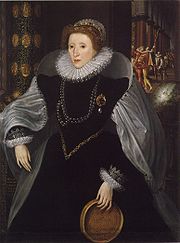
Christopher Hatton
Sir Christopher Hatton was an English politician, Lord Chancellor of England and a favourite of Elizabeth I of England.-Early days:...
(his heraldic badge
Heraldic badge
A heraldic badge is an emblem or personal device worn as a badge to indicate allegiance to or the property of an individual or family. Medieval forms are usually called a livery badge, and also a cognizance...
of the white hind appears on the sleeve of one of the courtiers in the background), and the work may express opposition to the proposed marriage of Elizabeth to François, Duke of Anjou
François, Duke of Anjou
Francis, Duke of Anjou and Alençon was the youngest son of Henry II of France and Catherine de' Medici.-Early years:...
.
The virgin Tuccia was familiar to Elizabethan readers from Petrarch
Petrarch
Francesco Petrarca , known in English as Petrarch, was an Italian scholar, poet and one of the earliest humanists. Petrarch is often called the "Father of Humanism"...
's "The Triumph of Chastity". Another symbol from this work is the spotless ermine
Ermine
Ermine has several uses:* A common name for the stoat * The white fur and black tail end of this animal, which is historically worn by and associated with royalty and high officials...
, wearing a collar of gold studded with topazes. This symbol of purity appears in the Ermine Portrait of 1585, attributed to the herald
Herald
A herald, or, more correctly, a herald of arms, is an officer of arms, ranking between pursuivant and king of arms. The title is often applied erroneously to all officers of arms....
William Segar
William Segar
Sir William Segar was a portrait painter and officer of arms to the court of Elizabeth I of England who became Garter King of Arms under James I....
. The queen bears the olive branch of Pax (Peace), and the sword of justice rests on the table at her side. In combination, these symbols represent not only the personal purity of Elizabeth but the "righteousness and justice of her government."
Visions of empire
.jpg)
Armada Portrait
The Armada Portrait of Elizabeth I of England is the name of any of three surviving versions of an allegorical panel painting depicting the Tudor queen surrounded by symbols of imperial majesty against a backdrop representing the defeat of the Spanish Armada in 1588.-Imagery:The combination of a...
is an allegorical
Allegory
Allegory is a demonstrative form of representation explaining meaning other than the words that are spoken. Allegory communicates its message by means of symbolic figures, actions or symbolic representation...
panel painting depicting the queen surrounded by symbols of empire against a backdrop representing the defeat of the Spanish Armada
Spanish Armada
This article refers to the Battle of Gravelines, for the modern navy of Spain, see Spanish NavyThe Spanish Armada was the Spanish fleet that sailed against England under the command of the Duke of Medina Sidonia in 1588, with the intention of overthrowing Elizabeth I of England to stop English...
in 1588.
There are three surviving versions of the portrait, in addition to several derivative paintings. The version at Woburn Abbey
Woburn Abbey
Woburn Abbey , near Woburn, Bedfordshire, England, is a country house, the seat of the Duke of Bedford and the location of the Woburn Safari Park.- Pre-20th century :...
, the seat of the Dukes of Bedford
Duke of Bedford
thumb|right|240px|William Russell, 1st Duke of BedfordDuke of Bedford is a title that has been created five times in the Peerage of England. The first creation came in 1414 in favour of Henry IV's third son, John, who later served as regent of France. He was made Earl of Kendal at the same time...
, is generally accepted as the work of George Gower, who had been appointed Serjeant Painter
Serjeant Painter
The Serjeant Painter was an honorable and lucrative position with the British monarchy. It carried with it the prerogative of painting and gilding all of the King's residences, coaches, banners, etc. and it grossed over £ 1,000 in a good year by the 18th century...
in 1581. A version in the National Portrait Gallery, London, which has been cut down at both sides leaving just a portrait of the queen, is also attributed to Gower. A third version, owned by the Tyrwhitt-Drake family, may have been commissioned by Sir Francis Drake
Francis Drake
Sir Francis Drake, Vice Admiral was an English sea captain, privateer, navigator, slaver, and politician of the Elizabethan era. Elizabeth I of England awarded Drake a knighthood in 1581. He was second-in-command of the English fleet against the Spanish Armada in 1588. He also carried out the...
. Scholars agree that this version is by a different hand, noting distinctive techniques and approaches to the modelling of the queen's features.
The combination of a life-sized portrait of the queen with a horizontal format is "quite unprecedented in her portraiture", although allegorical portraits in a horizontal format, such as Elizabeth I and the Three Goddesses and the Family of Henry VIII: An Allegory of the Tudor Succession pre-date the Armada Portrait.
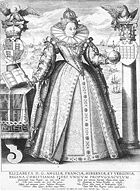
Pillars of Hercules
The Pillars of Hercules was the phrase that was applied in Antiquity to the promontories that flank the entrance to the Strait of Gibraltar. The northern Pillar is the Rock of Gibraltar in the British overseas territory of Gibraltar...
, gateway to the Atlantic Ocean and the New World.
In the background view on the left, English fireships threaten the Spanish fleet, and on the right the ships are driven onto a rocky coast amid stormy seas by the "Protestant Wind
Protestant Wind
The phrase Protestant Wind has been used in more than one context, notably:#The storm that lashed the Spanish Armada. According to Protestant propaganda, the wind wrecked the Spanish fleet and thus saved England from invasion by the army of Philip II of Spain...
". On a secondary level, these images show Elizabeth turning her back on storm and darkness while sunlight shines where she gazes.
An engraving by Crispijn van de Passe (Crispin van de Passe), published in 1596 but showing costume of the 1580s, carries similar iconography. Elizabeth stands between two columns bearing her arms and the Tudor heraldic badge
Heraldic badge
A heraldic badge is an emblem or personal device worn as a badge to indicate allegiance to or the property of an individual or family. Medieval forms are usually called a livery badge, and also a cognizance...
of a portcullis
Portcullis
A portcullis is a latticed grille made of wood, metal, fibreglass or a combination of the three. Portcullises fortified the entrances to many medieval castles, acting as a last line of defence during time of attack or siege...
. The columns are surmounted by her emblems of a pelican in her piety and a phoenix, and ships fill the sea behind her.
The cult of Elizabeth
_by_marcus_gheeraerts_the_younger.jpg)
Venus (mythology)
Venus is a Roman goddess principally associated with love, beauty, sex,sexual seduction and fertility, who played a key role in many Roman religious festivals and myths...
, the goddess of love. Another exaltation of the queen's virgin purity identified her with the moon goddess who holds dominion over the waters. Sir Walter Raleigh
Walter Raleigh
Sir Walter Raleigh was an English aristocrat, writer, poet, soldier, courtier, spy, and explorer. He is also well known for popularising tobacco in England....
had begun to use Diana
Diana (mythology)
In Roman mythology, Diana was the goddess of the hunt and moon and birthing, being associated with wild animals and woodland, and having the power to talk to and control animals. She was equated with the Greek goddess Artemis, though she had an independent origin in Italy...
and later Cynthia as aliases for the queen in his poetry around 1580, and images of Elizabeth with jewels in the shape of crescent moons or the huntress's arrows begin to appear in portraiture around 1586 and multiply through the remainder of the reign.. Courtiers wore the image of the Queen to signify their devotion, and had their portraits painted wearing her colours of black and white.
The Ditchley Portrait seems to have always been at the Oxfordshire home of Elizabeth's retired Champion, Sir Henry Lee of Ditchley
Henry Lee of Ditchley
Sir Henry Lee KG , of Ditchley, was Master of the Ordnance under Queen Elizabeth I of England.-Life:Lee became Queen Elizabeth I’s champion in 1570 and was appointed Master of the Royal Armouries in 1580, an office which he held until his death...
, and likely was painted for (or commemorates) her two-day visit to Ditchley in 1592. The painting is attributed to Marcus Gheerearts the Younger, and was almost certainly based on a sitting arranged by Lee, who was the painter's patron. In this image, the queen stands on a map of England, her feet on Oxfordshire. The painting has been trimmed and the background poorly repainted, so that the inscription and sonnet are incomplete. Storms rage behind her while the sun shines before her, and she wears a jewel in the form of a celestial or armillary sphere
Armillary sphere
An armillary sphere is a model of objects in the sky , consisting of a spherical framework of rings, centred on Earth, that represent lines of celestial longitude and latitude and other astronomically important features such as the ecliptic...
close to her left ear. Many versions of this painting were made, likely in Gheeraerts' workshop, with the allegorical items removed and Elizabeth's features "softened" from the stark realism of her face in the original. One of these was sent as a diplomatic gift to the Grand Duke of Tuscany
Ferdinando I de' Medici, Grand Duke of Tuscany
Ferdinando I de' Medici, Grand Duke of Tuscany was Grand Duke of Tuscany from 1587 to 1609, having succeeded his older brother Francesco I.-Biography:...
and is now in the Palazzo Pitti
Palazzo Pitti
The Palazzo Pitti , in English sometimes called the Pitti Palace, is a vast mainly Renaissance palace in Florence, Italy. It is situated on the south side of the River Arno, a short distance from the Ponte Vecchio...
.
The last sitting and the Mask of Youth
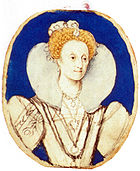

Engraving
Engraving is the practice of incising a design on to a hard, usually flat surface, by cutting grooves into it. The result may be a decorated object in itself, as when silver, gold, steel, or glass are engraved, or may provide an intaglio printing plate, of copper or another metal, for printing...
s of the queen. Only a single finished miniature from this pattern survives, with the queen's features softened, and Strong concludes that this realistic image from life of the aging Elizabeth was not deemed a success.
Prior to the 1590s, woodcuts and engravings of the queen were created as book illustrations, but in this decade individual prints of the queen first appear, based on the Oliver face pattern. In 1596, the Privy Council ordered that unseemly portraits of the queen which had caused her "great offence" should be sought out and burnt, and Strong suggest that these prints, of which comparatively few survive, may be the offending images. Strong writes "It must have been exposure to the searching realism of both Gheeraerts and Oliver that provoked the decision to suppress all likenesses of the queen that depicted her as being in any way old and hence subject to mortality."
In any event, no surviving portraits dated between 1596 and Elizabeth's death in 1603 show the aging queen as she truly was. All subsequent images rely on a face pattern devised by Nicholas Hilliard sometime in the 1590s called by art historians the "Mask of Youth", portraying Elizabeth as ever-young. Some 16 miniatures by Hilliard and his studio are known based on this face pattern, with different combinations of costume and jewels likely painted from life, and it was also adopted by (or enforced on) other artists associated with the Court.
The coronation portraits
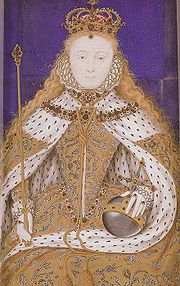
Coronation
A coronation is a ceremony marking the formal investiture of a monarch and/or their consort with regal power, usually involving the placement of a crown upon their head and the presentation of other items of regalia...
robes survive, both dated to 1600 or shortly thereafter. One is a panel portrait in oils (above) and the other is a miniature by Nicholas Hilliard. The warrant to the queen's tailor for remodelling Mary I's cloth of gold coronation robes for Elizabeth survives, and costume historian Janet Arnold
Janet Arnold
Janet Arnold was a British clothing historian, costume designer, teacher, conservator, and author.She funded the Janet Arnold Award to further in-depth study of Western dress, administered by the Society of Antiquaries of London...
's study points out that the paintings accurately reflect the written records, although the jewels differ in the two paintings,, suggesting two different sources, one possibly a miniature by Levina Teerlinc. It is not known why, and for whom, these portraits were created; at or just after the end of the reign.
The Rainbow Portrait
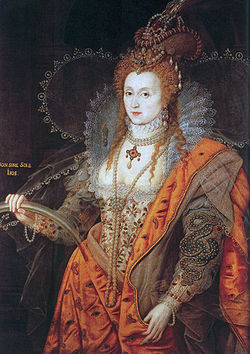
Isaac Oliver
Isaac Oliver was a French-born English portrait miniature painter.-Life and work:Born in Rouen, he moved to London in 1568 with his Huguenot parents Peter and Epiphany Oliver to escape the Wars of Religion in France...
, perhaps the most heavily symbolic portrait of the queen is the Rainbow Portrait. It was painted around 1600–1602, when the queen was in her sixties. In this painting an ageless Elizabeth appears dressed as if for a masque
Masque
The masque was a form of festive courtly entertainment which flourished in 16th and early 17th century Europe, though it was developed earlier in Italy, in forms including the intermedio...
, in a linen bodice embroidered
Embroidery
Embroidery is the art or handicraft of decorating fabric or other materials with needle and thread or yarn. Embroidery may also incorporate other materials such as metal strips, pearls, beads, quills, and sequins....
with spring flowers and a mantle draped over one shoulder, her hair loose beneath a fantastical headdress. She wears symbols out of the popular emblem book
Emblem book
Emblem books are a category of mainly didactic illustrated book printed in Europe during the 16th and 17th centuries, typically containing a number of emblematic images with explanatory text....
s: the cloak with eyes and ears, the serpent of wisdom, the celestial armillary sphere
Armillary sphere
An armillary sphere is a model of objects in the sky , consisting of a spherical framework of rings, centred on Earth, that represent lines of celestial longitude and latitude and other astronomically important features such as the ecliptic...
, and carries a rainbow with the motto non sine sol iris ("no rainbow without the sun"). Strong suggests that the complex "programme" for this image may be the work of the poet John Davies
John Davies (poet)
Sir John Davies was an English poet and lawyer, who became attorney general in Ireland and formulated many of the legal principles that underpinned the British Empire.-Early life:...
, whose Hymns to Astraea honouring the queen use much of the same imagery, and suggests it was commissioned by Robert Cecil
Robert Cecil, 1st Earl of Salisbury
Robert Cecil, 1st Earl of Salisbury, KG, PC was an English administrator and politician.-Life:He was the son of William Cecil, 1st Baron Burghley and Mildred Cooke...
as part of the decor for Elizabeth's visit in 1602, when a "shrine to Astraea" featured in the entertainments of what would prove to be the "last great festival of the reign".
Books and coins

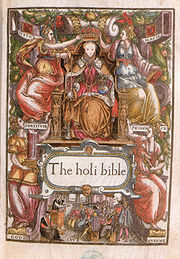
Coin
A coin is a piece of hard material that is standardized in weight, is produced in large quantities in order to facilitate trade, and primarily can be used as a legal tender token for commerce in the designated country, region, or territory....
age. In December 1560, a systematic recoinage of the debased money then in circulation was begun. The main early effort was the issuance of sterling silver
Sterling silver
Sterling silver is an alloy of silver containing 92.5% by mass of silver and 7.5% by mass of other metals, usually copper. The sterling silver standard has a minimum millesimal fineness of 925....
shilling
Shilling
The shilling is a unit of currency used in some current and former British Commonwealth countries. The word shilling comes from scilling, an accounting term that dates back to Anglo-Saxon times where it was deemed to be the value of a cow in Kent or a sheep elsewhere. The word is thought to derive...
s and groats, but new coins were issued in both silver and gold. This restoration of the currency was one of the three principal achievements noted on Elizabeth's tomb, illustrating the value of stable currency to her contemporaries. Later coinage represented the queen in iconic fashion, with the traditional accompaniments of Tudor
Tudor dynasty
The Tudor dynasty or House of Tudor was a European royal house of Welsh origin that ruled the Kingdom of England and its realms, including the Lordship of Ireland, later the Kingdom of Ireland, from 1485 until 1603. Its first monarch was Henry Tudor, a descendant through his mother of a legitimised...
heraldic badges including the Tudor rose
Tudor rose
The Tudor Rose is the traditional floral heraldic emblem of England and takes its name and origins from the Tudor dynasty.-Origins:...
and portcullis
Portcullis
A portcullis is a latticed grille made of wood, metal, fibreglass or a combination of the three. Portcullises fortified the entrances to many medieval castles, acting as a last line of defence during time of attack or siege...
.
Books provided another widely-available source of images of Elizabeth. Her portrait appeared on the title page of the Bishops' Bible
Bishops' Bible
The Bishops' Bible is an English translation of the Bible which was produced under the authority of the established Church of England in 1568. It was substantially revised in 1572, and this revised edition was to be prescribed as the base text for the Authorized King James Version of...
, the standard Bible of the Church of England
Church of England
The Church of England is the officially established Christian church in England and the Mother Church of the worldwide Anglican Communion. The church considers itself within the tradition of Western Christianity and dates its formal establishment principally to the mission to England by St...
, issued in 1568 and revised in 1572. In various editions, Elizabeth is depicted with her orb and sceptre accompanied by female personifications.
"Reading" the portraits

Renaissance
The Renaissance was a cultural movement that spanned roughly the 14th to the 17th century, beginning in Italy in the Late Middle Ages and later spreading to the rest of Europe. The term is also used more loosely to refer to the historical era, but since the changes of the Renaissance were not...
understanding of English history and destiny, filtered by allusion
Allusion
An allusion is a figure of speech that makes a reference to, or representation of, people, places, events, literary work, myths, or works of art, either directly or by implication. M. H...
s to Petrarch
Petrarch
Francesco Petrarca , known in English as Petrarch, was an Italian scholar, poet and one of the earliest humanists. Petrarch is often called the "Father of Humanism"...
's sonnet
Sonnet
A sonnet is one of several forms of poetry that originate in Europe, mainly Provence and Italy. A sonnet commonly has 14 lines. The term "sonnet" derives from the Occitan word sonet and the Italian word sonetto, both meaning "little song" or "little sound"...
s and, late in the reign, to Edmund Spenser
Edmund Spenser
Edmund Spenser was an English poet best known for The Faerie Queene, an epic poem and fantastical allegory celebrating the Tudor dynasty and Elizabeth I. He is recognised as one of the premier craftsmen of Modern English verse in its infancy, and one of the greatest poets in the English...
's Faerie Queene. Dame Frances Yates
Frances Yates
Dame Frances Amelia Yates DBE was a British historian. She taught at the Warburg Institute of the University of London for many years.She wrote extensively on the occult or Neoplatonic philosophies of the Renaissance...
points out that the most complexly symbolic portraits may all commemorate specific events or have been designed as part of elaborate themed entertainments. The most familiar images of Elizabeth—the Armada, Ditchley, and Rainbow portraits—are all associated with unique events in this way. To the extent that the contexts of other portraits have been lost to scholars, so too the keys to understanding these remarkable images as the Elizabethans understood them may be lost in time. Even those portraits that are not overtly allegorical may be full of meaning to a discerning eye. Elizabethan courtiers familiar with the language of flowers
Language of flowers
The language of flowers, sometimes called floriography, was a Victorian-era means of communication in which various flowers and floral arrangements were used to send coded messages, allowing individuals to express feelings which otherwise could not be spoken...
and the Italian emblem books could have read stories in the blooms the queen carried, the embroidery on her clothes, and the design of her jewels.
According to Roy Strong
Roy Strong
Sir Roy Colin Strong FRSL is an English art historian, museum curator, writer, broadcaster and landscape designer. He has been director of both the National Portrait Gallery and the Victoria and Albert Museum in London...
,
Fear of the wrong use and perception of the visual image dominates the Elizabethan age. The old pre-Reformation idea of images, religious ones, was that they partook of the essence of what they depicted. Any advance in technique which could reinforce that experience was embraced. That was now reversed, indeed it may account for the Elizabethans failing to take cognisance of the optical advances which created the art of the Italian Renaissance ... They certainly knew about these things but, and this is central to the understanding of the Elizabethans, chose not to employ them. Instead the visual arts retreated in favour of presenting a series of signs or symbols through which the viewer was meant to pass to an understanding of the idea behind the work. In this manner the visual arts were verbalised, turned into a form of book, a 'text' which called for reading by the onlooker. There are no better examples of this than the quite extraordinary portraits of the queen herself, which increasingly, as the reign progressed, took on the form of collections of abstract pattern and symbols disposed in an unnaturalistic manner for the viewer to unravel, and by doing so enter into an inner vision of the idea of monarchy."
See also
- 1550–1600 in fashion
- Artists of the Tudor CourtArtists of the Tudor courtThe artists of the Tudor court are the painters and limners engaged by the monarchs of England's Tudor dynasty and their courtiers between 1485 and 1603, from the reign of Henry VII to the death of Elizabeth I....
- Cultural depictions of Elizabeth I of EnglandCultural depictions of Elizabeth I of EnglandElizabeth I of England has inspired artistic and cultural works for over four centuries. The following lists cover various media, enduring works of high art, and recent representations in popular culture, film and fiction...

